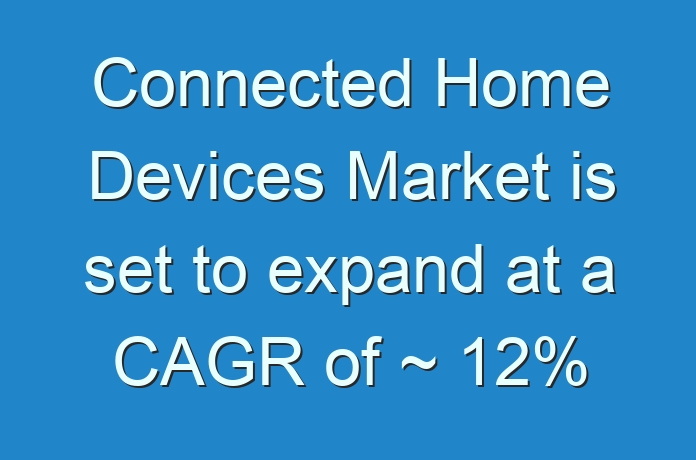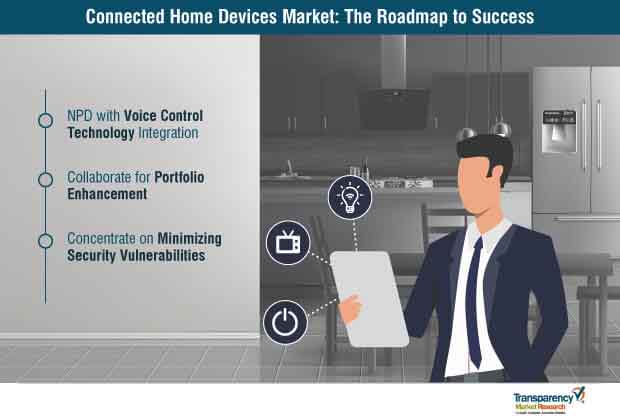
Modern consumers are placing major emphasis on life improvements, and creating an intelligent ecosystem that allows them to ease everyday tasks and achieve efficiency. Connected home devices, along with smart home integration, are becoming vital factors influencing the purchase decisions of new home buyers. Presently, huge growth is being witnessed in products and systems designed to enhance and change the way consumers live their lives inside their homes. The demand for such devices is increasing like never before, as they are being incorporated and standardized in future homes.
A recent report published by Transparency Market Research (TMR) on the connected home devices market, highlights the key aspects pertaining to the industry that are likely to drive market growth in the coming years. According to TMR’s report, the connected homes devices market is expected to expand at a CAGR of ~ 12%. The growth of the market is driven by the rising penetration of next-gen technologies in devices that enable superior connectivity and performance enhancement.

Planning to lay down future strategy? Perfect your plan with our report brochure here
Mapping the Evolutionary Path of the Connected Home Devices Market
Initially, smart homes was an idea, and not an actual implementation. While technological advancements continued at a slow pace, science fiction explored the idea of home automation through its mention in certain stories. The timeline of home automation marks the spawn of connected home devices that revolutionized the experience of living in modern homes. For early adopters, the idea of a completely operational connected home has been a techie dream, which was intangible until the past few years. While the birth of the Internet of Things (IoT) marked the dawn of the connected era, connected homes were envisioned through the ages.
The 1890s witnessed the development of remote controls, while home appliances made headway between the 1901 and 1920. Around 1966, the world witnessed a revolutionary discovery in the form of ECHO IV, a home automation machine. It was designed to control a home’s temperature, compute shopping lists, and turn appliances on or off, although its main drawback was its large size. The epoch of automation was then felt in 2010 and beyond, as companies continued to launch technologically-enhanced connective home devices. Banking on the increasing acceptance of these gadgets, the connected home devices market is expected to witness sales of ~ 240 million units, globally, in 2019.
Want to know the obstructions to your company’s growth in future? Buy Your Report here
Impact of Undercurrents
AI to Redefine the Connected Home Experience
Artificial Intelligence (AI) is laying the ground for extraordinary possibilities across a plethora of end-use industries. Similar transformations driven by AI are also witnessed across the connected home devices landscape. Connected home devices augmented with AI offer superior traceability and convenience to enhance the way consumers deal with their daily chores, thereby redefining the connected home experience.
Popularity of Smart Entertainment Devices to Act as Catalyst for Growth
While connected home devices gain impetus on account of the increasing significance given to consumer convenience in homes, smart home entertainment devices continue to gain popularity. Among these, video entertainment devices are likely to grab a major share, with the consistently growing demand for seamless entertainment in the form of streaming media.
Building on Cloud Technology
Companies operating in the connected home devices market are building on cloud technology to develop next-gen products that offer seamless integration to modern tech-savvy consumers. As cloud computing enables users to obtain real-time information, directly through web browsers, it remains a sought-after factor to push the adoption of connected home devices.
Connected Home Devices Alluring Hackers
Although the growth of IoT devices coupled with the evolution of digital technologies continues, connected home device manufacturers have been unsuccessful in producing reliable and secure products. Security threats continue to pertain, as consumers, while purchasing new homes, prefer homes integrated with connected home devices. This has led to the likelihood of hand-me-down security vulnerabilities, thereby posing a threat to the market for connected home devices.





